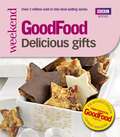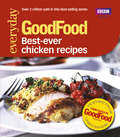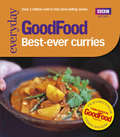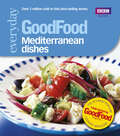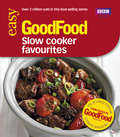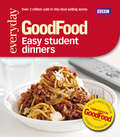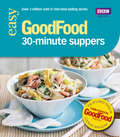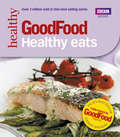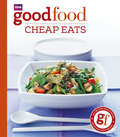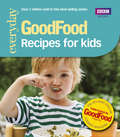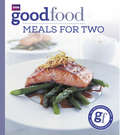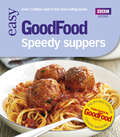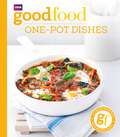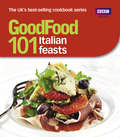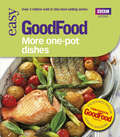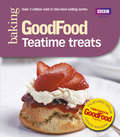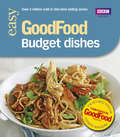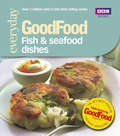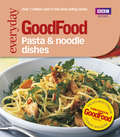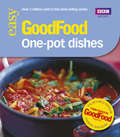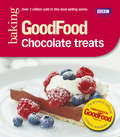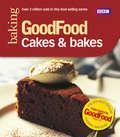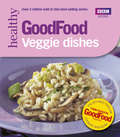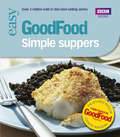- Table View
- List View
Good Food: Triple-tested Recipes
by Good Food GuidesWhen it comes to giving gifts, there's nothing more personal than something that you've made yourself - and what could be better than some delicious presents from the kitchen? Whether you're saying thank you with Chocolate Macaroons, celebrating Christmas with Mini Panettone or treating your valentine to some Cherry Shortbread Hearts, gourmet gifts are always a welcome treat.Using their knack for clever ideas and triple-tested tips, the team at Good Food magazine has come up with 101 of their favourite foodie gifts, so you can celebrate any occasion with an array of tasty food and drink. From dishes for special occasions like Halloween and Valentine's Day, to recipes for using up a seasonal glut of fruit and veg, 101 Delicious Gifts is packed with sweet treats, jams, chutneys and gourmet gift packs to ensure your presents are always well received.Accompanied by colour photographs and full nutritional breakdowns throughout, this handy cookbook will provide you with year-round inspiration for gifts from the kitchen.
Good Food: Triple-tested Recipes
by Good Food GuidesChicken is one of the most versatile ingredients. It's perfect for economical quick-fix dishes, for a special dinner, for guests, at home, or eaten hot or cold. It can be easily transformed into a flavoursome snack or a tasty treat. With 101 ideas, there's a chicken recipe for every occasion in this handy cookbook, from warming classics and perfect convenience food to a taste of the exotic and meals to impress. With straight-forward, tried-and-tested recipes taken from Britain's top-selling BBC Good Food Magazine you can be sure of mouth-watering chicken meals whatever your mood.
Good Food: Triple-tested Recipes
by Good Food GuidesHot and spicy, mild, creamy and comforting, Thai, Indian, Malaysian, Indonesian - the word 'curry' encompasses a huge variety of exciting dishes. With long lists of spices and unfamiliar ingredients, it might seem like a complex dish to cook and leave you more inclined to call for a takeway, but once you know the basics, creating a delicious curry is simple. Including quick curries when you're short on time, classic curry dishes made easy, delicious side dishes and new ideas using curry spices, and plenty of vegetarian ideas, Good Food has collected 101 of their most popular curry recipes. Every idea is accompanied by a full-colour photograph and a nutritional breakdown so you can create a home-cooked curry with complete confidence and know exactly what is in every bite.
Good Food: Triple-tested Recipes
by Good Food GuidesEven if it is raining outside, this little book of sunshine will help lift the gloom with a wealth of comforting, cheerful dishes to keep the summer atmosphere alive. All tried-and-tested by Britain's top-selling BBC Good Food Magazine, these Mediterranean recipes are guaranteed to be packed full of intense flavour. With full-colour photography to accompany every dish and a practical ingredients list of Mediterranean authentics and easy-to-find alternatives, this really is a must-have summer cookbook.
Good Food: Triple-tested Recipes
by Good Food GuidesFor those of us with busy lifestyles and little time to spare, slow cookers are a priceless helping hand in the kitchen - with as little as 10 minutes spent preparing a dish at the beginning of the day, you can enjoy delicious food a few hours later without slaving away at a hot stove. That's why the trusted experts at Good Food magazine, the UK's best-selling cookery magazine, have put together this essential guide to making the most of your slow cooker. With recipes for comfort food favourites like curries, chillis, soups and puddings, through to fresh ideas for meaty stews, braised fish and melt-in-the-mouth vegetarian meals, there is a slow-cooked meal to suit every taste and occasion.Accompanied throughout with full-colour photographs and a nutritional breakdown of every recipe, this collection of Good Food's favourite triple-tested slow cooker recipes will work first time, every time. A blend of timeless classics, clever twists and irresistible flavours, Slow Cooker Favourites is packed with recipe ideas for a whole host of mouth-watering treats.
Good Food: Triple-tested Recipes
by Good Food GuidesMaking tasty and healthy dishes can be difficult for students - with a tight schedule and an even tighter budget, the odds are stacked against you. That's why the trusted team at Good Food magazine have collected their favourite recipes for quick, delicious dishes that won't cost the earth or require hard-to-find ingredients and specialist equipment. Chapters on Brainy Breakfasts help to keep body and mind going until lunch, while Express Dinners are perfect for those busy weeknight evenings. There is also a handy collection of dishes for one, as well as a chapter of hearty Food for Friends that won't break the bank. The full nutritional breakdown accompanying each dish helps you to maintain a healthy diet, and with a colour photograph accompanying each recipe it really couldn't be simpler. 101 Easy Student Dinners is the ideal cookbook for the student way of life - quick, healthy and delicious food that leaves you with the time, energy and money to study and socialise.
Good Food: Triple-tested Recipes
by Good Food GuidesIt's always difficult to balance a hectic schedule with tasty, healthy meals, so it helps to have foolproof recipes that you can rely on to provide delicious food in no time. With this in mind, the team of experts at Good Food magazine have collected 101 of their best-loved recipes for cooking mouth-watering meals in 30 minutes or less!From light bites for a weeknight meal on the run to great ideas for last-minute entertaining, 101 30-minute Suppers is packed with tips and inspiration for creating delicious pasta, grills, seafood and more with the minimum of fuss. Because every dish has been triple-tested in the Good Food kitchen, you can try new and varied dishes with complete confidence in half an hour or under - with ideas to serve just one or two, a whole family or even an entire dinner party!With quick and easy recipes, each one accompanied by a photograph and a nutritional breakdown, this cookbook offers the very best of Britain's best-selling cookery magazine, without any hassle.
Good Food: Triple-tested Recipes
by Good Food GuidesLooking after yourself doesn't mean you have to compromise on flavour. Nowadays, there is a huge choice of delicious ingredients that can be turned into a satisfying and nutritious meal with a little inspiration. In 101 Healthy Eats, the Good Food team prove you can really enjoy food that's good for you. This little cookbook is full of tasty low-fat recipes that are high in fibre and packed with vitamins and minerals. The choice of healthy recipes includes such tasty treats as Quick prawn and almond korma, Sticky maple pork with apples, Gnocchi with roasted squash and goat's cheese and even Crispy fish and chips with mushy peas! Healthy eating doesn't mean you can't enjoy a dessert or two so try tangy Red currant sorbet and indulgent Toffee apple pudding. Get inspiration from:Classics made healthyHealthy mid-week mealsSide dishes and saladsHealthy meals without meatGuilt-free entertainingSweet and lowGood Food is Britain's top-selling cookery magazine. With simple step-by-step instructions, and a full-colour photograph and nutritional breakdown to accompany each recipe, you can cook nourishing food with complete confidence.
Good Food: Triple-tested Recipes
by Good Food GuidesDivided into Salads, Snacks and Light Meals; Pasta and Noodles; Meat; Fish; One-pot Dishes and Desserts, with Good Food: Cheap Eats you're guaranteed to find a delicious, cheap recipe for every occasion.Whether you choose Sausage and Potato Bake, Pork and Tarragon Meatloaf or Canadian Pecan Tart, every recipe has been tried and tested by the BBC Good Food Magazine team to ensure fantastic results, every time you cook.The 101 recipes are all short and simple with easy-to-follow steps, using readily available ingredients and are accompanied by a full-colour photograph of the finished dish.
Good Food: Triple-tested Recipes
by Good Food GuidesPreparing fresh and healthy dishes and then getting your child to eat them can seem far from an easy task for busy parents. With this inspirational collection of recipes taken from Britain's top-selling BBC Good Food Magazine, the Good Food team prove you don't have to devote hours to a hot stove to give your children home-cooked meals, and fast food doesn't have to mean deep-fried or mass produced. Full of quick, easy and nutritional recipes using practical ingredients, a nutritional breakdown so you know exactly what you're giving your child and full-colour photos of each dish, this compact cookbook is a must for parents.
Good Food: Triple-tested Recipes
by Good Food GuidesWhen you want to create a delicious lunch for two, an appetizing snack to share or something special for a romantic dinner, Good Food Meals for Two will provide you with all the inspiration you'll need. The team at Good Food Magazine have gathered together a host of fail-safe, mouth-watering recipes that are specially designed for two people, ranging from the delicious yet simple Spicy Chicken Couscous to tasty feasts such as Seared Beef with Bean Mash. With chapters that include Starters, Salads & Snacks, Special-occasion Meals, Low-fat & Healthy, and Something Sweet, you'll find fresh ideas and new takes on recipes in this tantalizing selection of meals for two. Each recipe is accompanied by a full-page colour photograph and simple step-by-step instructions to ensure a winning result every time.
Good Food: Triple-tested Recipes
by Good Food GuidesSpeedy Suppers is perfect for busy people who still want to eat home-cooked food. It's full of tasty meal ideas that can all be cooked in 30 minutes or less, using readily available ingredients, with helpful time-saving tips. Including recipes for main courses, sides, snacks and desserts, plenty of vegetarian options and ideas for cooking for one, two, a hungry family or a special-occasion dinner, all the recipes were created and triple-tested by Britain's best-selling cookery magazine, to make cooking good food as quick and easy as possible. Each one of the simple recipes is accompanied by a full-colour photograph and a nutritional breakdown, so you can cook balanced meals with complete confidence.
Good Food: Triple-tested Recipes
by Good Food GuidesA pot of something delicious simmering away on the stove never fails to tantalise the tastebuds. Whether it's a creamy soup, a fragrant curry or a traditional English pudding, there are endless ideas for one-pot cooking in this book. The team at BBC Good Food Magazine have gathered their tried-and-trusted recipes together to create another fail-safe book of ideas in this hugely popular series. Each recipe is accompanied by a full-page colour photograph so you can create a winner every time. With simple recipes for starters, main courses and desserts, you'll find all you need for inspiration in this handy little cookbook.This edition is revised and updated with brand new recipes and a fresh new look.
Good Food: Triple-tested Recipes
by Good Food GuidesWhether you want to make a moreish snack for tea, or bake a perfect cake for a special occasion, Good Food: Bakes and Cakes serves up fabulous baking ideas for tasty treats. Taken from Britains top-selling BBC Good Food magazine, these imaginitive and easy recipes are guaranteed to guide you to baking success. From such delicious classics as Authentic Yorkshire Parkin and Shortbread, and the imaginative combinations of Raspberry and Blueberry Lime Drizzle Cake or Cranberry and Poppy Seed Muffins, to spectacular cakes such as Seriously Rich Chocolate Cake, there's plenty to keep your family and friends happy. These quick and easy recipes have been specially chosen to help even the busiest people enjoy delicious, fresh, home-cooked food. Each recipe is written with simple step-by-step instructions and is accompanied by a useful nutritional analysis and a full-colour photograph, so you can cook with complete confidence.This edition is revised and updated with brand new recipes and a fresh new look.
Good Food: Triple-tested Recipes
by Jane HornbyFor quick, easy and mouth-watering food, look no further than Italian cooking. Using the minimum of ingredients and just a touch of Mediterranean inspiration, Italians have always been able to create dishes that take little effort but can delight and dazzle the tastebuds. There are meal ideas to suit every occasion in this handy cookbook: from light snacks and easy treats to meaty stews and a wealth of pasta recipes - wholesome Bolognese, creamy carbonara, rich lasagne and fresh and zingy pesto, to name but a few.With the team at Good Food, the UK's best-selling cookery magazine, triple-testing each recipe, you can be confident that each dish will work first time. Accompanied by full nutritional breakdowns and colour photographs throughout, 101 Italian Feasts is the ideal guide to the delights that Italian food has to offer.
Good Food: Triple-tested Recipes
by Jane HornbyFinding wholesome meals that don't require hours in the kitchen can sometimes be tricky, and unfamiliar or complex recipes can be off-putting. That's why Good Food have put together another compact cookbook of recipe suggestions that will appeal to all the family and can be cooked with minimum effort - using just one pot. It's full of classic, balanced and easy-to-prepare dinners perfect for busy weeknights, as well as more relaxed weekend mealtimes. 101 More One-pot Dishes caters for all tastes, with veggie ideas, great dishes for entertaining and even delicious desserts.Every recipe is accompanied by a full-colour photograph and a nutritional breakdown so you can serve your family healthy, home-cooked, tried-and-tested food every day of the week.
Good Food: Triple-tested Recipes
by Jane HornbyFollowing on from the success of 101 Cakes and Bakes, the Good Food team have collected the very best of their latest recipes for cakes, tray bakes, biscuits, loaf cakes, muffins, tarts and pastries that are perfect for teatime or whenever you want something sweet and delicious. There are festive ideas and party suggestions, celebration cakes, a section especially for chocoholics and some speedy ideas for a quick sugar fix. Try Sticky lime and coconut drizzle loaf, Mango and passionfruit roulade, Marbled chocolate brownies and Caramel custard apple tart. There's a delicous baking recipe for everyone with:Large and loaf cakesTray bakes and biscuitsFresh fruit cakesChocolate cakes and bakesSmall cakes and muffinsTarts and pastries All the recipes have been tested in the Good Food kitchen and with simple step-by-step instructions, a nutritional breakdown and a full-colour photo to accompany every idea, you're guaranteed a delicious bake every time.
Good Food: Triple-tested Recipes
by Jane HornbyEating on a budget doesn't mean a dull menu - with a little inspiration from the Good Food team, you can enjoy delicious food and save the pennies too. 101 Budget Dishes is full of economical and creative meal ideas made with everyday ingredients, from quick snacks and comforting casseroles and pasta to new ideas for storecupboard staples, as well as inexpensive entertaining suggestions and penny-saving puds. Each simple recipe comes with a nutritional breakdown, full colour photo and step-by-step instructions. With every recipe tried and tested by Good Food, Britain's best-selling cookery magazine, you can be sure of tasty, well-balanced meals that won't break the bank.
Good Food: Triple-tested Recipes
by Jeni WrightFish and seafood are a healthy, versatile and delicious choice, and to prove that cooking with these ingredients doesn't have to be complicated or time-consuming, the team at BBC Good Food Magazine have collected their favourite recipes for Good Food 101 Fish & Seafood Dishes. You'll never be stuck for ideas with these tasty, easy recipes, from Smoked Salmon and Dill Tartlets to Spicy Singaporean Fish, in chapters that include Simple Everyday Suppers, Easy Entertaining, Healthy & Low-Fat and Asian Flavours. As each recipe is accompanied by a full-page colour photograph and step-by-step instructions, creating delicious fish and seafood dishes in your own kitchen has never been so simple.
Good Food: Triple-tested Recipes
by Jeni WrightSo versatile, so quick and so healthy, pasta and noodles are the ultimate convenience foods. Whether you want a speedy after-work supper or a more substantial meal for friends at the weekend, you'll never be stuck for recipe ideas with Good Food 101 Pasta & Noodle Dishes. This inspirational collection of mouth-watering recipes taken from BBC Good Food Magazine includes such tantalizing dishes as Smoked Salmon and Asparagus Pasta, Rigatoni Sausage Bake and Prawn Cakes with Spicy Noodles. From creamy, comforting pasta dishes to spicy, flavoursome noodles, there really is a recipe for everyone.From the hugely popular 101 series, each recipe is accompanied by a full page picture so that cooks of every ability can easily follow the instructions and achieve superb results every time.
Good Food: Triple-tested Recipes
by Jeni WrightA pot of something delicious simmering away on the stove never fails to tantalise the tastebuds. Whether it's a creamy soup, a fragrant curry or a traditional English pudding, there are endless ideas for one-pot cooking in this book. The team at BBC Good Food Magazine have gathered their tried-and-trusted recipes together to create another fail-safe book of ideas in the hugely popular 101 series. Each recipe is accompanied by a full-page colour photograph so you can create a winner every time. With simple recipes for starters, main courses and desserts, you'll find all you need for inspiration in this handy little cookbook
Good Food: Triple-tested Recipes
by Jeni WrightWhatever the occasion, whatever the mood, there's always a place on the menu for chocolate; whether it's cakes and bakes for tea-time, cookies for hungry home-coming schoolchildren, or sophisticated dinner party desserts. In Good Food 101 Chocolate Treats, the team at BBC Good Food Magazine brings you an array of simple recipes from Mocha Fudge Cake and Pear, Hazelnut and Chocolate Cake to Pistachio, Orange and Oat Crumbles and Cappucino Bars. A feast of treats so you can truly tantalise your tastebuds.
Good Food: Triple-tested Recipes
by Mary CadoganWhether you want to make a moreish snack for tea, or bake a perfect cake for a special occasion, Good Food 101 Cakes and Bakes serves up fabulous baking ideas for tasty treats. Taken from Britains top-selling BBC Good Food magazine, these imaginitive and easy recipes are guaranteed to guide you to baking success. From such delicious classics as Authentic Yorkshire Parkin and Shortbread, and the imaginative combinations of Raspberry and Blueberry Lime Drizzle Cake or Cranberry and Poppy Seed Muffins, to spectacular cakes such as Seriously Rich Chocolate Cake, there's plenty to keep your family and friends happy. These quick and easy recipes have been specially chosen to help even the busiest people enjoy delicious, fresh, home-cooked food. Each recipe is written with simple step-by-step instructions and is accompanied by a useful nutritional analysis and a full-colour photograph, so you can cook with complete confidence.
Good Food: Triple-tested Recipes
by Orlando MurrinFor exciting vegetarian recipe ideas, try Good Food 101 Veggie Dishes. Divided into Soups, Salads and Snacks; Light Meals; Pasta, Rice and Noodles; Main Courses; Dairy-free Dishes and Desserts, you're guaranteed to find a tasty vegetarian recipe for every occasion. Whether you choose Lemon Butter Gnocchi, Purple Sprouting Broccoli, Potato and Blue Cheese Gratin or Banana Muesli Toffee Crunch, every recipe has been tried and tested by the Good Food team to ensure fantastic results, every time you cook.Taken from BBC Good Food Magazine, Britain's top cookery title, the recipes are all short and simple with easy-to-follow steps, using readily available ingredients and are accompanied by a full-colour photograph of the finished dish.
Good Food: Triple-tested Recipes
by Orlando MurrinDivided into Starters and Salads; Snacks and Light Meals; Pasta and Rice and Noodles; Poultry and Meat; Fish and Seafood, and Desserts, you're guaranteed to find a delicious, easy recipe for every occasion in Good Food 101 Simple Suppers. Taken from BBC Good Food Magazine, Britains top cookery title, the 101 recipes are all short and simple with easy-to-follow steps, using readily available ingredients and are accompanied by a full-colour photograph of the finished dish. Whether you choose Turkey and Wild Mushroom Fusilli, Lamb with Root Vegetable Crush or Roasted Nectarine with Ginger Crumbs, every recipe has been tried and tested by the Good Food team to ensure fantastic results, every time you cook.
